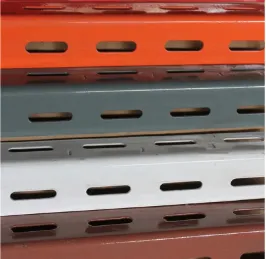-
+86 15030157877
-
sales@galvanizedmetalmesh.com
Ago . 19, 2025 17:08 De volta à lista
Angle Bar: A Solid Skeleton in Shelf Construction
In the construction of storage shelves, Angle Bar, with its unique structure and reliable performance, has become the core material supporting various types of shelves. Under its seemingly simple appearance, it contains strong load-bearing capacity and flexible combination characteristics, providing a solid foundation for the efficient utilization of storage space.

The structural characteristics of Angle Bar make it an ideal choice for shelf construction
Galvanized angle steel has an "L" - shaped cross-section with two sides perpendicular to each other. This structure allows it to evenly distribute loads under pressure and tension, and has excellent mechanical stability. The common Angle Bar materials are mostly carbon structural steel or low-alloy high-strength steel. After being processed by rolling, galvanizing and other processes, it not only has high strength and good toughness, but also has strong corrosion resistance, which can adapt to the damp, dusty and other environments that may exist in the warehouse.
In shelf construction, the performance advantage of Angle Bar is particularly significant
Its load-bearing capacity is outstanding. Depending on the specifications, a single barra angular de aço can withstand hundreds of kilograms or even several tons of weight, which is sufficient to support the storage of various types of goods. Moreover, Angle Bar has excellent processing performance and can be cut, drilled, welded and processed according to the design requirements of the shelf, making it easy to assemble into shelves of different sizes and structures. In addition, the galvanized Angle Bar can effectively resist corrosion, extend the service life of the shelf, reduce maintenance costs, and ensure that the shelf remains stable and reliable in long-term use.
The application forms of Angle Bar in shelves are diverse and abundant
In lightweight shelves, smaller sized stainless steel angles are usually used as columns and beams, which are assembled through bolt connections. The structure is simple and easy to disassemble, making it suitable for storing lightweight goods; Medium sized shelves use medium-sized Angle Bars, combined with reinforcement to enhance overall stability, which can be used to store heavier boxed or bulk goods; In some customized shelves, Angle Bar can also be combined with other materials, such as steel plates to form shelves, and wire mesh to separate goods and meet different storage needs.
With the development of the warehousing industry, the application of Angle Bar in the shelving field is constantly being optimized
In response to the storage requirements of different goods, steel angle varieties with different thicknesses and materials have emerged. For example, high-strength low-alloy Angle Bar can be used for heavy-duty shelves to meet greater load-bearing needs; In terms of connection methods, in addition to traditional welding and bolt connections, more convenient assembly methods such as snap fit have also been developed to improve the installation efficiency of shelves. At the same time, the surface treatment process of Angle Bar is also being upgraded. In addition to galvanizing, spray painting, powder coating and other methods have also emerged to enhance protection and match different colors according to the warehouse environment.
In summary, Angle Bar has become an indispensable key material in shelf construction due to its unique "L" - shaped structure, excellent load-bearing performance, good processability, and diverse application forms. It ensures the safe storage of goods with solid support capabilities and adapts to the needs of different warehousing scenarios with flexible combination characteristics. With the continuous improvement of shelf requirements in the warehousing industry, Angle Bar will continue to develop in terms of specification optimization and performance enhancement, providing more reliable support for efficient warehousing.
Angle Bar FAQs
What is the load-bearing capacity of the Angle Bar shelf and how many items is it suitable for?
The load-bearing capacity of Angle Bar shelves mainly depends on the material thickness, structural design, and assembly method. Ordinary Angle Bar shelves can carry 100-300 kilograms per layer, while heavy-duty shelves can reach over 500 kilograms after reinforcement. Suggest selecting appropriate specifications based on actual needs and placing items evenly to avoid deformation caused by local overloading.
Why are Angle Bar shelves so popular in the warehousing industry?
Angle Bar shelves have advantages such as low cost, flexible installation, and strong durability. Its modular design facilitates free adjustment of floor height and adapts to storage of goods of different sizes. After surface rust prevention treatment, it has a long service life and an open structure for easy access, making it particularly suitable for use in small and medium-sized warehouses or retail stores.
Is the assembly of Angle Bar shelves complicated and does it require professional tools?
The assembly process of Angle Bar shelves is simple and usually only requires a wrench and screwdriver to complete. The accessory package will come with a detailed manual and use bolt connection without welding. Pay attention to keeping the frame vertical during installation and ensure that all connection points are tightened to enhance overall stability.
How to prevent Angle Bar shelves from rusting and extend their service life?
Choosing Angle Bar material that is hot-dip galvanized or coated with anti rust paint can effectively prevent corrosion. When used in humid environments, regularly wipe the shelves with a dry cloth to avoid water accumulation. If paint damage is found, it should be repaired in a timely manner. It is recommended to install moisture-proof pads for long-term storage of damp items.
What materials are available for Angle Bar shelf shelves and what are their characteristics?
There are three common types of laminated boards: wooden boards, steel mesh, and steel plates. Wooden boards are cost-effective but have low load-bearing capacity. Steel mesh has strong breathability and is suitable for storing ventilated items such as fruits and vegetables. Steel plates have the best load-bearing capacity and are easy to clean, but the cost is relatively high. Can be mixed and used according to the characteristics of the stored items.
-
Stainless Steel Wire Mesh | 304/316, Factory Direct Prices
NotíciasNov.17,2025
-
Stainless Steel Wire Mesh – Durable, Rust-Resistant, Exact
NotíciasNov.17,2025
-
Expanded Metal Mesh: Custom, Durable, Factory-Direct Supply
NotíciasNov.17,2025
-
Security Window Screen Mesh | Stainless Steel, Anti-Theft
NotíciasNov.17,2025
-
Anti Bird Spikes Exporter – Durable Humane OEM Wholesale
NotíciasNov.17,2025
-
Metal Mesh Fabric For Glass Laminated - UV-Stable, Custom
NotíciasNov.11,2025



